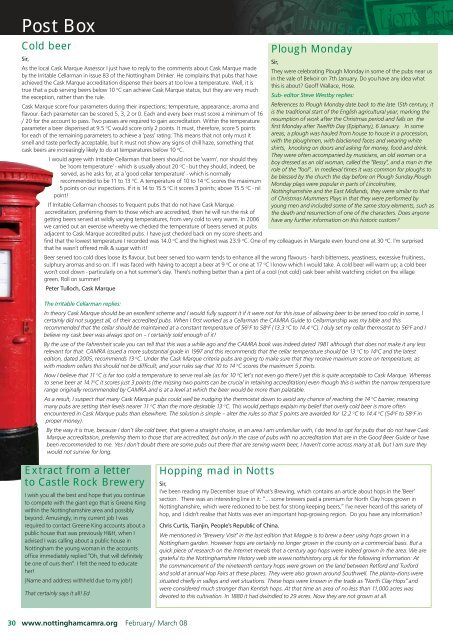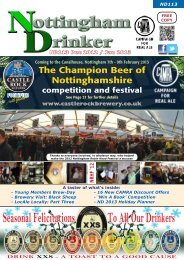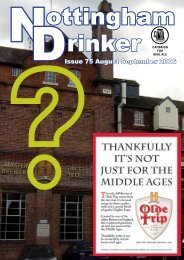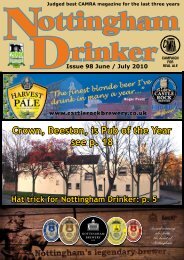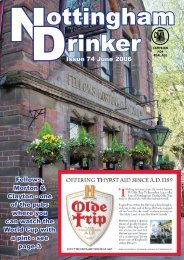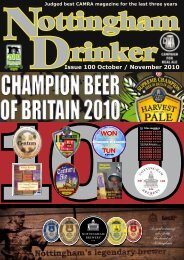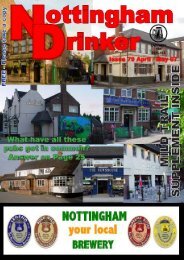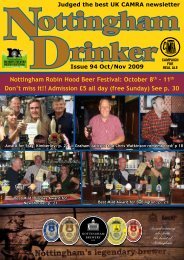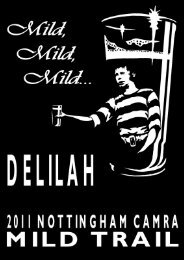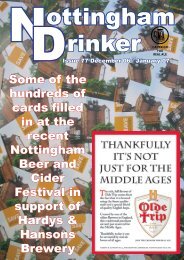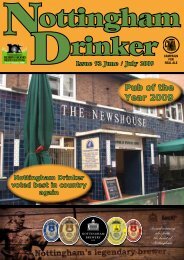New brewery and visitor centre for Belvoir - Nottingham CAMRA
New brewery and visitor centre for Belvoir - Nottingham CAMRA
New brewery and visitor centre for Belvoir - Nottingham CAMRA
Create successful ePaper yourself
Turn your PDF publications into a flip-book with our unique Google optimized e-Paper software.
Post Box<br />
Cold beer<br />
Sir,<br />
As the local Cask Marque Assessor I just have to reply to the comments about Cask Marque made<br />
by the Irritable Cellarman in Issue 83 of the <strong>Nottingham</strong> Drinker. He complains that pubs that have<br />
achieved the Cask Marque accreditation dispense their beers at too low a temperature. Well, it is<br />
true that a pub serving beers below 10 o C can achieve Cask Marque status, but they are very much<br />
the exception, rather than the rule.<br />
Cask Marque score four parameters during their inspections; temperature, appearance, aroma <strong>and</strong><br />
flavour. Each parameter can be scored 5, 3, 2 or 0. Each <strong>and</strong> every beer must score a minimum of 16<br />
/ 20 <strong>for</strong> the account to pass. Two passes are required to gain accreditation. Within the temperature<br />
parameter a beer dispensed at 9.5 o C would score only 2 points. It must, there<strong>for</strong>e, score 5 points<br />
<strong>for</strong> each of the remaining parameters to achieve a 'pass' rating. This means that not only must it<br />
smell <strong>and</strong> taste perfectly acceptable, but it must not show any signs of chill haze, something that<br />
cask beers are increasingly likely to do at temperatures below 10 o C.<br />
I would agree with Irritable Cellarman that beers should not be 'warm', nor should they<br />
be 'room temperature' - which is usually about 20 o C - but they should, indeed, be<br />
served, as he asks <strong>for</strong>, at a 'good cellar temperature' - which is normally<br />
recommended to be 11 to 13 o C. A temperature of 10 to 14 o C scores the maximum<br />
5 points on our inspections. If it is 14 to 15.5 o C it scores 3 points; above 15.5 o C - nil<br />
point!<br />
If Irritable Cellarman chooses to frequent pubs that do not have Cask Marque<br />
accreditation, preferring them to those which are accredited, then he will run the risk of<br />
getting beers served at wildly varying temperatures, from very cold to very warm. In 2006<br />
we carried out an exercise whereby we checked the temperature of beers served at pubs<br />
adjacent to Cask Marque accredited pubs. I have just checked back on my score sheets <strong>and</strong><br />
Plough Monday<br />
Sir,<br />
They were celebrating Plough Monday in some of the pubs near us<br />
in the vale of <strong>Belvoir</strong> on 7th January. Do you have any idea what<br />
this is about? Geoff Wallace, Hose.<br />
Sub- editor Steve Westby replies:<br />
References to Plough Monday date back to the late 15th century, it<br />
is the traditional start of the English agricultural year, marking the<br />
resumption of work after the Christmas period <strong>and</strong> falls on the<br />
first Monday after Twelfth Day (Epiphany), 6 January. In some<br />
areas, a plough was hauled from house to house in a procession,<br />
with the ploughmen, with blackened faces <strong>and</strong> wearing white<br />
shirts, knocking on doors <strong>and</strong> asking <strong>for</strong> money, food <strong>and</strong> drink.<br />
They were often accompanied by musicians, an old woman or a<br />
boy dressed as an old woman, called the "Bessy", <strong>and</strong> a man in the<br />
role of the "fool".. In medieval times it was common <strong>for</strong> ploughs to<br />
be blessed by the church the day be<strong>for</strong>e on Plough Sunday.Plough<br />
Monday plays were popular in parts of Lincolnshire,<br />
<strong>Nottingham</strong>shire <strong>and</strong> the East Midl<strong>and</strong>s, they were similar to that<br />
of Christmas Mummers Plays in that they were per<strong>for</strong>med by<br />
young men <strong>and</strong> included some of the same story elements, such as<br />
the death <strong>and</strong> resurrection of one of the characters. Does anyone<br />
have any further in<strong>for</strong>mation on this historic custom?<br />
find that the lowest temperature I recorded was 14.0 o C <strong>and</strong> the highest was 23.9 o C. One of my colleagues in Margate even found one at 30 o C. I'm surprised<br />
that he wasn't offered milk & sugar with it!<br />
Beer served too cold does loose its flavour, but beer served too warm tends to enhance all the wrong flavours - harsh bitterness, yeastiness, excessive fruitiness,<br />
sulphury aromas <strong>and</strong> so on. If I was faced with having to accept a beer at 9 o C or one at 17 o C I know which I would take. A cold beer will warm up; a cold beer<br />
won't cool down - particularly on a hot summer's day. There's nothing better than a pint of a cool (not cold) cask beer whilst watching cricket on the village<br />
green. Roll on summer!<br />
Peter Tulloch, Cask Marque<br />
The Irritable Cellarman replies:<br />
In theory Cask Marque should be an excellent scheme <strong>and</strong> I would fully support it if it were not <strong>for</strong> this issue of allowing beer to be served too cold in some, I<br />
certainly did not suggest all, of their accredited pubs. When I first worked as a Cellarman the <strong>CAMRA</strong> Guide to Cellarmanship was my bible <strong>and</strong> this<br />
recommended that the cellar should be maintained at a constant temperature of 56 o F to 58 o F (13.3 o C to 14.4 o C). I duly set my cellar thermostat to 56 o F <strong>and</strong> I<br />
believe my cask beer was always spot on – I certainly sold enough of it!<br />
By the use of the Fahrenheit scale you can tell that this was a while ago <strong>and</strong> the <strong>CAMRA</strong> book was indeed dated 1981 although that does not make it any less<br />
relevant <strong>for</strong> that. <strong>CAMRA</strong> issued a more substantial guide in 1997 <strong>and</strong> this recommends that the cellar temperature should be 13 o C to 14 o C <strong>and</strong> the latest<br />
edition, dated 2005, recommends 13 o C. Under the Cask Marque criteria pubs are going to make sure that they receive maximum score on temperature, as<br />
with modern cellars this should not be difficult, <strong>and</strong> your rules say that 10 to 14 o C scores the maximum 5 points.<br />
Now I believe that 11 o C is far too cold a temperature to serve real ale (as <strong>for</strong> 10 o C let’s not even go there!) yet this is quite acceptable to Cask Marque. Whereas<br />
to serve beer at 14.1 o C it scores just 3 points (the missing two points can be crucial in retaining accreditation) even though this is within the narrow temperature<br />
range originally recommended by <strong>CAMRA</strong> <strong>and</strong> is at a level at which the beer would be more than palatable.<br />
As a result, I suspect that many Cask Marque pubs could well be nudging the thermostat down to avoid any chance of reaching the 14 o C barrier, meaning<br />
many pubs are setting their levels nearer 11 o C than the more desirable 13 o C. This would perhaps explain my belief that overly cold beer is more often<br />
encountered in Cask Marque pubs than elsewhere. The solution is simple – alter the rules so that 5 points are awarded <strong>for</strong> 12.2 o C to 14.4 o C (54 o F to 58 o F in<br />
proper money).<br />
By the way it is true, because I don’t like cold beer, that given a straight choice, in an area I am unfamiliar with, I do tend to opt <strong>for</strong> pubs that do not have Cask<br />
Marque accreditation, preferring them to those that are accredited, but only in the case of pubs with no accreditation that are in the Good Beer Guide or have<br />
been recommended to me. Yes I don't doubt there are some pubs out there that are serving warm beer, I haven't come across many at all, but I am sure they<br />
would not survive <strong>for</strong> long.<br />
Extract from a letter<br />
to Castle Rock Brewery<br />
I wish you all the best <strong>and</strong> hope that you continue<br />
to compete with the giant ego that is Greene King<br />
within the <strong>Nottingham</strong>shire area <strong>and</strong> possibly<br />
beyond. Amusingly, in my current job I was<br />
required to contact Greene King accounts about a<br />
public house that was previously H&H, when I<br />
advised I was calling about a public house in<br />
<strong>Nottingham</strong> the young woman in the accounts<br />
office immediately replied "Oh, that will definitely<br />
be one of ours then". I felt the need to educate<br />
her!<br />
(Name <strong>and</strong> address withheld due to my job!)<br />
That certainly says it all! Ed<br />
Hopping mad in Notts<br />
Sir,<br />
I've been reading my December issue of What's Brewing, which contains an article about hops in the 'Beer'<br />
section. There was an interesting line in it: “... some brewers paid a premium <strong>for</strong> North Clay hops grown in<br />
<strong>Nottingham</strong>shire, which were reckoned to be best <strong>for</strong> strong keeping beers.” I've never heard of this variety of<br />
hop, <strong>and</strong> I didn't realise that Notts was ever an important hop-growing region. Do you have any in<strong>for</strong>mation?<br />
Chris Curtis, Tianjin, People's Republic of China.<br />
We mentioned in "Brewery Visit" in the last edition that Magpie is to brew a beer using hops grown in a<br />
<strong>Nottingham</strong> garden. However hops are certainly no longer grown in the county on a commercial basis. But a<br />
quick piece of research on the Internet reveals that a century ago hops were indeed grown in the area. We are<br />
grateful to the <strong>Nottingham</strong>shire History web site www.nottshistory.org.uk <strong>for</strong> the following in<strong>for</strong>mation: At<br />
the commencement of the nineteenth century hops were grown on the l<strong>and</strong> between Ret<strong>for</strong>d <strong>and</strong> Tux<strong>for</strong>d<br />
<strong>and</strong> sold at annual Hop Fairs at these places. They were also grown around Southwell. The planta¬tions were<br />
situated chiefly in valleys <strong>and</strong> wet situations. These hops were known in the trade as "North Clay Hops" <strong>and</strong><br />
were considered much stronger than Kentish hops. At that time an area of no less than 11,000 acres was<br />
devoted to this cultivation. In 1880 it had dwindled to 29 acres. Now they are not grown at all.<br />
30 www.nottinghamcamra.org February/ March 08


